
The Project Gutenberg EBook of Pere Marquette State Park, by Anonymous This eBook is for the use of anyone anywhere in the United States and most other parts of the world at no cost and with almost no restrictions whatsoever. You may copy it, give it away or re-use it under the terms of the Project Gutenberg License included with this eBook or online at www.gutenberg.org. If you are not located in the United States, you'll have to check the laws of the country where you are located before using this ebook. Title: Pere Marquette State Park Author: Anonymous Release Date: May 11, 2019 [EBook #59482] Language: English Character set encoding: UTF-8 *** START OF THIS PROJECT GUTENBERG EBOOK PERE MARQUETTE STATE PARK *** Produced by Stephen Hutcheson, Lisa Corcoran and the Online Distributed Proofreading Team at http://www.pgdp.net

Guest House is attractive and comfortable

The hub of park activities is the rustic lodge
Sprawling picturesque Pere Marquette State Park and Conservation Area, located on the bluffs overlooking the gentle flowing Illinois river, offers many diversified forms of recreation and abounds in scenic beauty. The 5180 acre area is in Jersey county five miles west of Grafton on Illinois route 100 and approximately 19 miles west and north of Alton via the scenic Great River Road.
The park was named in memory of Father Jacques Marquette, the French Jesuit missionary priest, who in 1673 along with explorer Louis Jolliet were the first white men to enter what is now the State of Illinois at the confluence of the Mighty Mississippi and the Illinois rivers. A large white cross, east of the park entrance alongside route 100, marks where these two famous men landed.
The park with its 2605.90 acres and the conservation area consisting of 2574 acres were acquired by the state in 1932. The two areas adjoin each other. Across the Illinois river to the south and west is the Federal Wild Life Refuge of more than 8,000 acres.
Long popular and much used is the massive Pere Marquette Lodge built of colorful native stone and rustic timbers, and the seven stone guest houses back of it, nestling into the hillside. The guest houses with 29 rooms and the lodge with 18 rooms are all heated, completely air-conditioned, and each have televisions. The spacious dining room has maintained a continued reputation for exceptionally good food and gracious hospitality which spills over to the large lounge with a huge 700 ton stone fireplace, furnishing the ideal spot for old-fashioned corn popping or just plain loafing. There are also many outdoor activities including a swimming pool (open May 15 through September 15), a five-hole, par three, golf course, shuffleboard and horseshoe courts for lodge guests. Room or dining reservations should be made with the Pere Marquette Lodge management, Grafton, Illinois (A.C. 618—Grafton 786-3351).
The recreational facilities of the park are many and varied ranging from camping to hiking the many miles of foot trails, boating and fishing, picnicking or horseback riding the bridle paths, or viewing the many scenic wonders from the overlooks atop the bluffs. It’s family recreation at its best!
Camping is popular and in addition to primitive sites, the park affords trailer sites with electricity, shower baths, and flush toilets. Camping permits must be secured from the park ranger who will assign you a camping site. There are ample picnic areas with good shade, pure water, and picnic tables at designated areas. No open fires are permitted and no cooking can be done except on a park or camp stove. Playground equipment is provided for the children.
If you are a nature lover and wish to commune with nature, the park provides miles of foot trails. From April to October, a part-time naturalist is available for scheduled trips on the nature trails. At the beginning of the trail you will find a nature museum with excellent exhibits pertaining to animal and plant life, archaeology and geology of the park. The vast network of foot trails with scattered shelters, lead you to McAdams Peak where Dr. McAdams recovered 125 Indian skeletons, Quitt Point the highest point in the park or other popular overlooks. During the early spring the park abounds with the added beauty of white blossoming wild dogwood and redbud trees.
The modern new boat docks provide dockage for privately owned craft. The convenient concession stand has row boats for rent and arranges for scenic or speedboat rides. Fishing is an extremely popular pastime and the angler has the opportunity of catching a variety of fish from the waters of the Illinois.
Horseback riding over the 14 miles of bridle paths is another recreational feature of the park. A stable with good mounts is located within the park near the entrance.
Located in the Conservation Area, the organized youth group camping area is equipped with kitchens, mess halls, and swimming pools. These three areas, Camp Piasa, Camp Quatoga, and Camp Potawatomi are extensively used during the summer months and can accommodate approximately 365 youths. Reservations for the use of these facilities are made with the Division of Parks and Memorials, 100 State Office Building, Springfield 62706.

Cross marks site where Marquette and Jolliet entered Illinois in 1673
In Pere Marquette State Park there are 18 sites indicating occupation by prehistoric Americans and a village once located where the lodge now stands. It is believed that men, nomadic hunters and fishers, appeared in the Illinois valley possibly about the beginning of the Christian Era. Later stone age peoples by 900 A. D. made large leaf-shaped arrowheads and coarse, heavy pottery. By 1300 A. D. trade had developed and at Cahokia resulted in village-states. These peoples made small, finely-chipped arrowheads, pottery with handles and a variety of wares and cultivated corn, squash and beans.
When the French came to this region, the Illinois, Potawatomie and Kickapoo Indians were little removed from their ancestors whose cemeteries, burial mounds, house and village sites dotted the Illinois Valley as at the park.
Louis Jolliet and Father Jacques Marquette were sent by the French government over the Wisconsin portage, in the spring of 1673, to explore the Mississippi River for a passage to the Pacific Ocean. They coursed as far as the Arkansas River where they turned back and in September entered the Illinois River. The Marquette Monument, a large stone cross, alongside Route 100, commemorates this event as the recorded entrance of white men into Illinois.
Robert Cavilier, sieur de La Salle appeared shortly to govern and develop the region. His unbounded energy earned him the name “Prince of Explorers.”
He built Fort Creve Coeur near Peoria, now a state park, and in the spring of 1680 sent Father Louis Hennepin down the Illinois River to explore the upper Mississippi. Hennepin and his party spent five days at or across from the present lodge, waiting for the ice to go out of the Mississippi. On March 12, the expedition turned up the mighty Father of Waters. The Iroquois Indians invaded the Illinois valley that spring and mutinous soldiers destroyed Fort Creve Coeur as La Salle hiked to Montreal.
Learning of the wrecking of his enterprise, La Salle hurried to the Illinois valley to search for his companions, arriving at Pere Marquette State Park by canoe on December 7, 1680. On the north bank of the Illinois River he viewed the fury of the Iroquois, for here were Illinois women and children tortured to death by fire, impaled on poles.
Having found no trace of Frenchmen, he stripped the bark from the trunk of a tree, hung a board with a drawing of his party in a canoe, tied a letter to Tonti, his trusted lieutenant, to the board directing him to a cache of supplies hidden nearby.
On December 7, 1681, La Salle with a party of 22 Frenchmen, reunited with Tonti, rendezvoused with 18 Indians at the mouth of the Illinois River. This party remained 12 days building elm bark canoes for the long trip down the Mississippi. Three months later La Salle stood at the mouth of the river and claimed the Mississippi valley for France, naming it “Louisiana.”
La Salle’s successor in the Illinois country was Henri Tonti, an Italian in the French army. He had lost a hand in some battle, for which he substituted an iron one, which so impressed the Indians that he became famed as the man with the Iron Hand.
He served as guide to the Seminary Fathers who founded Cahokia, today the oldest permanent settlement in the Mississippi valley. This party stopped overnight at the mouth of the Illinois River on December 5, 1698.
In 1717 the Regent of France was influenced by John Law, a Scottish land speculator, to draw a line from the mouth of the Illinois River, extended east, which created New France (Canada) to the north and Louisiana to the south. Law’s scheme to colonize Louisiana waxed until 1720 when the “Mississippi Bubble” burst, nearly wrecking France.
On October 9, 1721, Pierre Francois de Charlevoix, a Jesuit college professor, sent by Louis XV’s Regent to search for the still undiscovered route to the Pacific Ocean passed this way. “For at this place,” he wrote in polished prose, “The River of the Illinois changes its course.... One might say, out of regret to its being obliged to pay the tribute of its waters to another river, it endeavors to return back to its source.”
The fur trade, flourishing with the Indians as middlemen, centered on the strategic Illinois waterway. The Indians controlled the region from the Fox War of the 1730’s through the French and Indian War of the 1760’s, the French having possession in name only.
When the British took hold in 1763, illegal fur trading began from the newly founded St. Louis, Calhoun Point being the place of crossing. Otter, beaver, wolf, deer and martin are the peltry mentioned as abounding from the mouth of the Illinois north.
By the Treaty of Greenville, Ohio, in August, 1795, the Indians ceded a twelve square mile tract at the mouth of the Illinois River, including free passage of the waterway.
In 1811 trouble with Indians saw the building of a blockhouse near the mouth of the Illinois River and another at the present Meppen, across the river from Goat Cliff.
Major Stephan H. Long in September, 1816, went by keelboat from St. Louis to Peoria with two soldiers and an interpreter, Francis Le Clair, the founder of Davenport, Iowa. This survey party returned overland south and west, reaching the Illinois River via the low ridge east of Quitt Point and Deerlick Hollow.
The autumn of 1818 found Gurdon S. Hubbard as a clerk on a bateau as an agent of Astor’s American Fur Company. Hubbard, only 18, tells of the party passing Pere Marquette State Park singing Canadian boat songs and spending the night of November 5 at the mouth of the Illinois, bound for St. Louis. This party returned in the first week of December as Illinois was accepted into the Union. Hubbard became a legendary figure in Illinois, living a full and adventurous life in the Illinois fur trade.
Five veterans of the regular army were the first settlers in this region this same year. One of these, David Gilbert, 5 settled on the bank of the lake now bearing his family name. George Finney, another veteran, platted the village of Camden in February, 1821, in the valley now bearing that name at the mouth of the Illinois river.

Corner of interesting nature museum
James Mason entered land in 1830 just to the east of Camden to establish a ferry to facilitate trade with St. Louis. Late in April, 1831, a flatboat drifted past here, manned by four men from the Sangamon country, bound for the New Orleans market. One of the crew, 22-year-old Abraham Lincoln, was to be indelibly impressed by the slave market at New Orleans.
Mason built a home on his land, founding Grafton in 1836. An earth wharf was built, becoming known as Mason’s Landing. In 1837 the town of Hartford was platted where the Pere Marquette lodge now stands. The church and school bearing this name are the sole reminders of this development today. The flood of 1844 wrecked Grafton and business shifted east to Alton.
When the Illinois and Michigan canal was opened in 1848 Mason’s Landing became a wood and coal center for the river traffic. Corded wood came from the surrounding forests and coal was kept in 2½ bushel boxes to maintain the steamboats. Large rafts of pine logs and lumber from Wisconsin appeared on the Mississippi River each spring, were caught at Grafton, and held backed up on the Illinois River, until needed farther down stream.
Quarrying began in 1857, and the old Lindell Hotel in St. Louis, and the piers of the Meredosia and Hannibal railroad bridges were built of Grafton stone. The Underground Railroad was a well kept secret of the period in Grafton, Calhoun Point being the rendezvous for escaped slaves.
The park bluffs command the first attention of the visitor. The four prominent hollows one views are ravines cut into an elevated plain. About 200 million years ago, what is now Illinois, was lifted from the sea for the last time and the age of the lizards followed. As the giant dinosaurs flourished, this region was the scene of earth movements that resulted in a dislocation of the rocks, producing the Lincoln Fold.
Thus it happens that one is now in the eastern end of the Lincoln Hills which extend 30 miles from Lincoln County, Missouri, into Jersey County, Illinois. To the north the bedrock was uplifted 50 feet per mile, and pulled down steeply hundreds of feet to the south. At Pere Marquette State Park the Illinois River has cut a section through these folded beds. Rocks dipping at 45 degrees are plainly visible at two places along the foot trail and bridle path to Twin Springs. Here one can climb the Lincoln Fold just to the north of the Nature Museum on the foot trail to Goat Cliff.
The life of those times, preserved as fossils, reveal the development of the higher invertebrates, then the fishes, and finally land animals and plants. At the foot of McAdams Peak, Twin Springs flows from Ordovician-Silurian rocks, deposited in the sea 350 million years ago. All the ridges are mantled with loess (pronounced “less”), wind blown dust laid down a million years ago at the time of the Great Ice Age. The vertical banks of yellow clay seen along the road to the upper areas are composed of this material, capped by the black topsoil that supports the present forest.
More than 60 species of trees have been listed; Pecans, Red Cedars and Butternuts being notable. Spring comes with the flowering of the Shadbush; Redbud and Wild Plum are succeeded by the even more lovely Dogwood. Flowers abound, and later berries light up dark places, and mosses, ferns and lichens, form an agreeable ensemble. Mushrooms are conspicuous for their number. With autumn the woods are a never-to-be-forgotten blaze of color.
The varied habitats support a vast and unusual assemblage of animals. Fish, as only the Illinois valley knows them, fatten in the waterways. All four species of lizards known in Illinois scamper over the lichen-covered rocks. The whole series of fur-bearing animals now left in Illinois are here to be seen. It may be that in these endless acres that a Whitetail Deer or Wildcat still lingers, certainly an occasional Coyote and the re-introduced Beaver.
Hundreds of species of birds, especially in time of migration, can be seen and studied to great advantage. The Mockingbird sings all day; the woods ring with the calls of Thrush, Wren and Towhee, and the fields echo with Meadow Lark and native sparrow songs. Vireo, Oriole and Cardinal are everywhere. Hawks, Vultures, and the symbol of the United States, the Bald Eagle, soar over McAdams Peak. Osprey, Herons, Bitterns, Cormorants, Grebes and Loons are about the water. Even Pelicans and Ibises appear in the summer. Especially in migration, Ducks, Geese, Gulls, and all the tribe of Sandpiper, Plover, Snipe, Cranes and Swans on very rare occasions. All these and many others frequent this part of the Mississippi Flyway, the migratory highway of central North America. This was the Indian’s happy hunting ground, now an American paradise in perpetuity.
For further information concerning Illinois State Parks and Memorials write to the DIVISION OF PARKS AND MEMORIALS, 100 State Office Building, Springfield, 62706.
Our numerous State Parks and Memorials are of easy access from every part of the state. Lodges, cabins, and dining rooms are important features of Illinois Beach, Starved Rock, Pere Marquette, White Pines Forest, and Giant City State Parks. Reservations for lodging should be made with lodge managers.
All State Parks are open the year round, except when weather condition necessitates the closing of park roads during the freezing and thawing periods. Then access to park facilities is by foot traffic only. All State Memorials open the year round except Thanksgiving, Christmas, and New Years.
(Printed by authority of the State of Illinois)
Issued by
DEPARTMENT OF CONSERVATION
Division of Parks and Memorials
50M—7-67
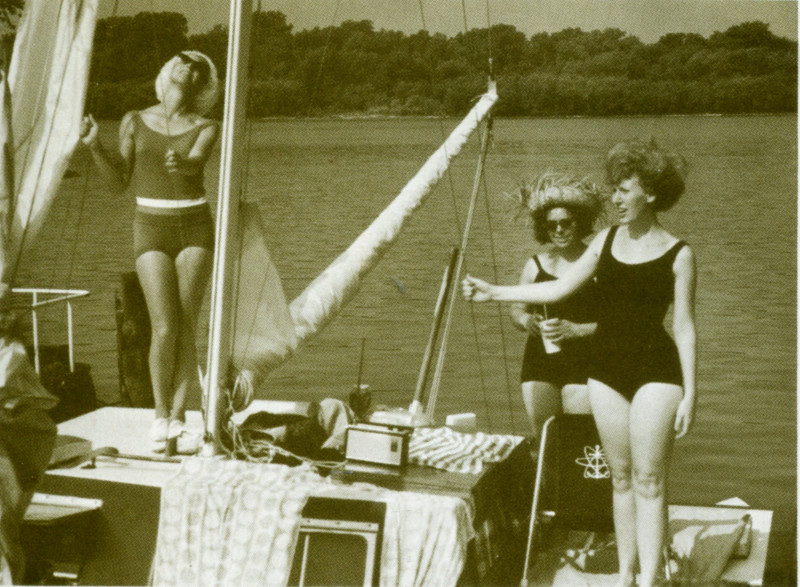
Illinois natural beauty sails around
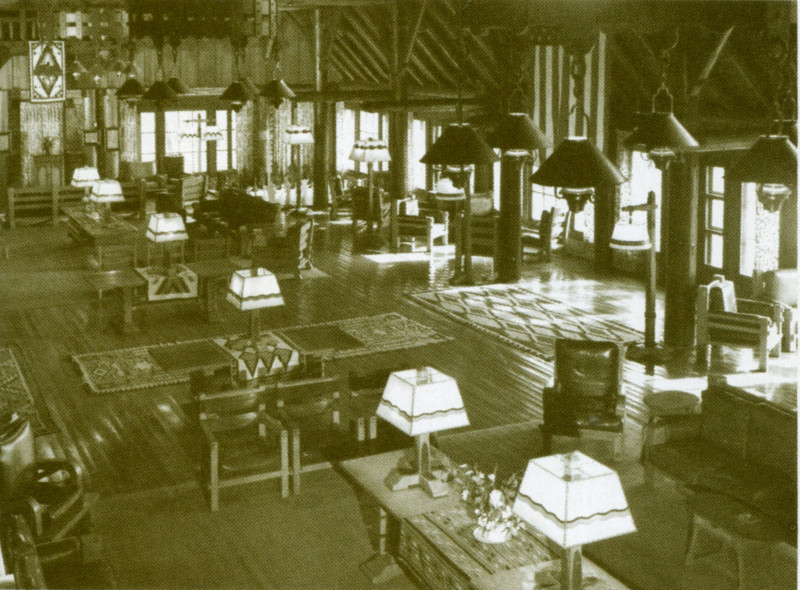
A magnetic charm dominates lodge lounge
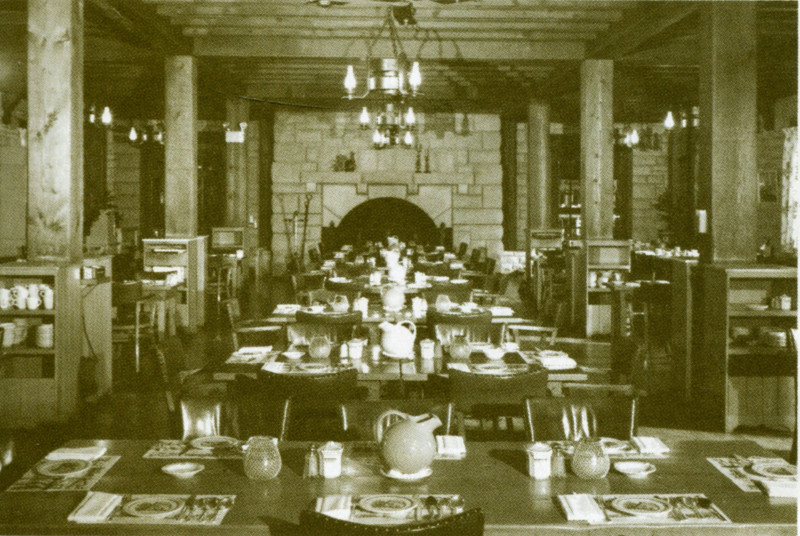
Excellent food complements dining room
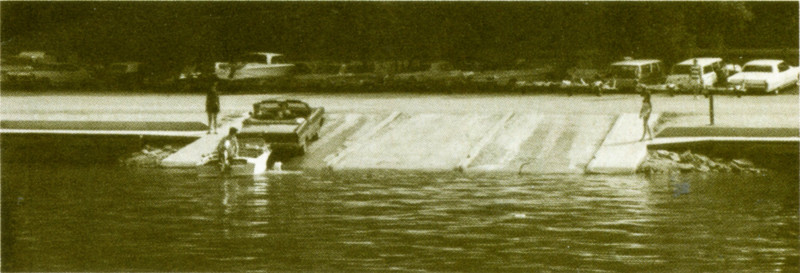
Three-lane boat ramp on Illinois River basin
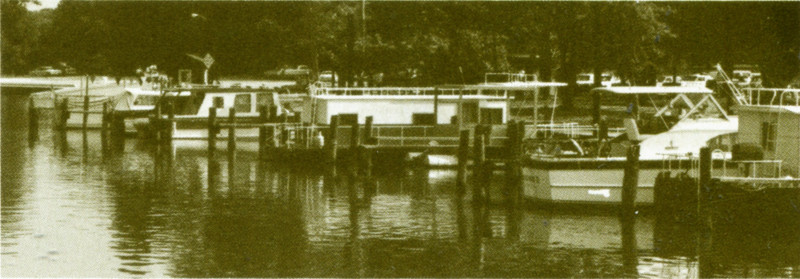
Docking area on Illinois River basin
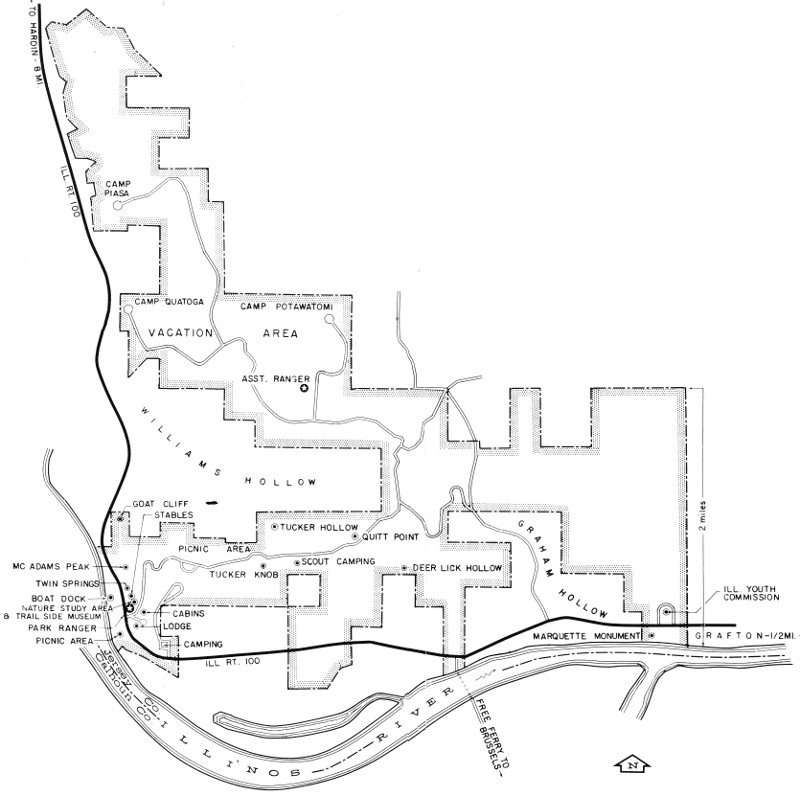
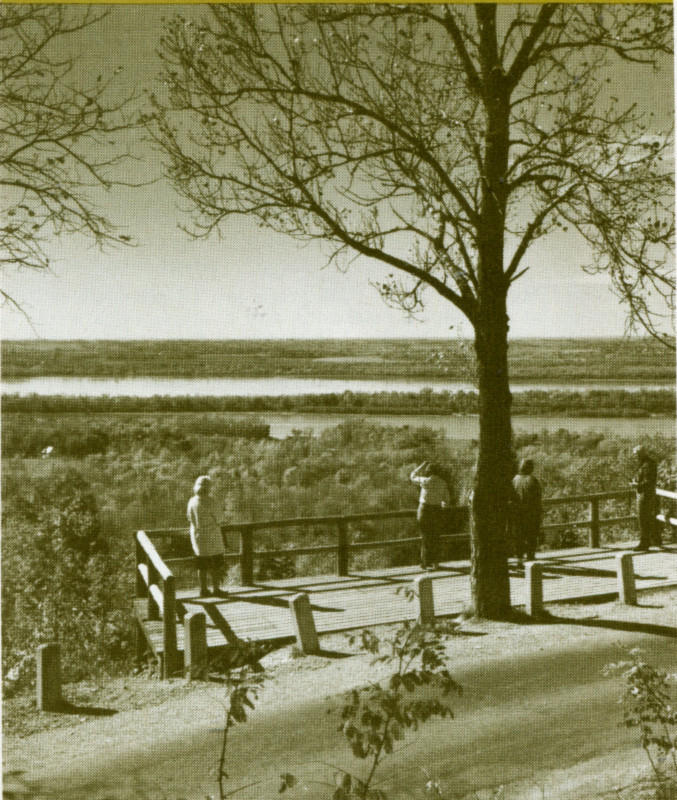
There are several observation points at Pere Marquette State Park. Take the road to the top of the bluffs. On a clear day, from the overlook near McAdams Peak, you can see the Illinois and Mississippi rivers and the backwaters of the Missouri River.
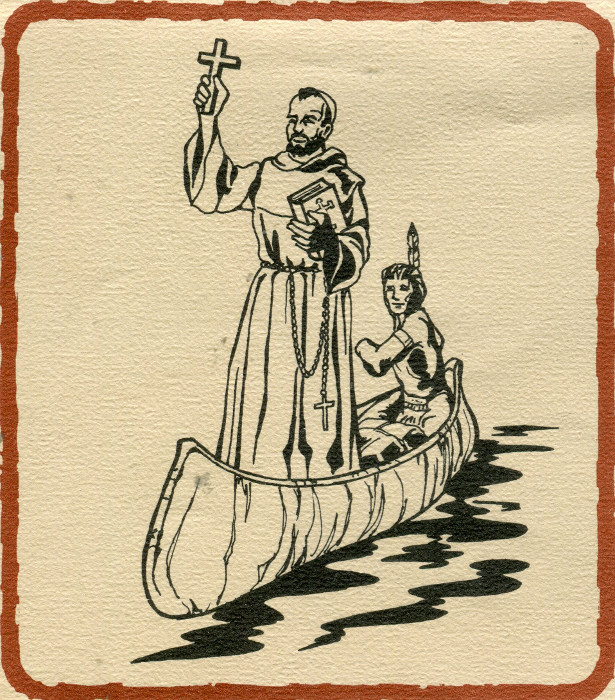
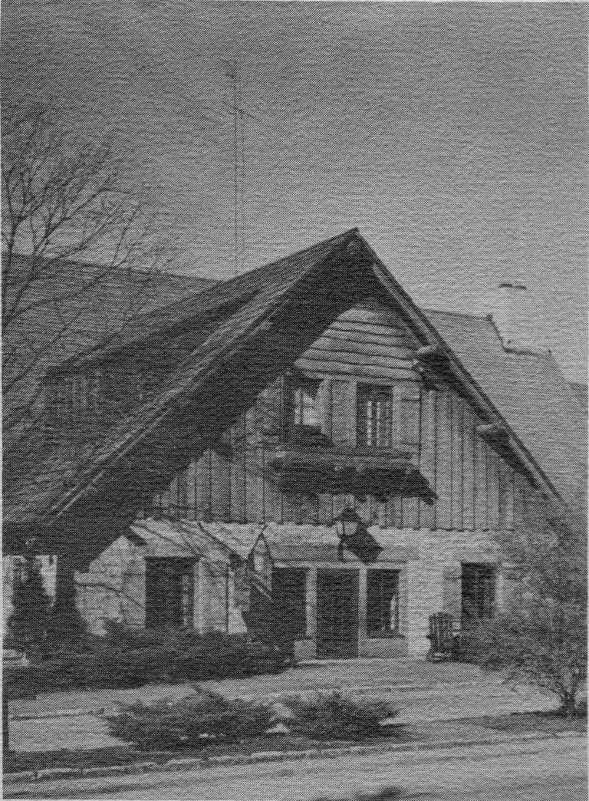
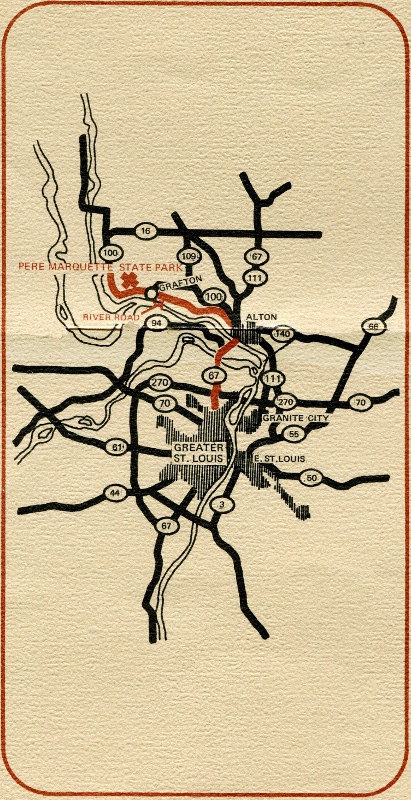

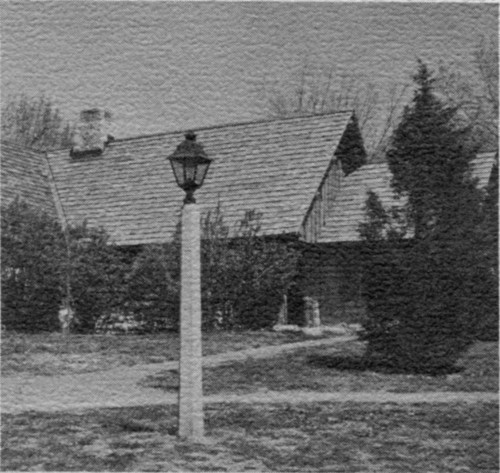
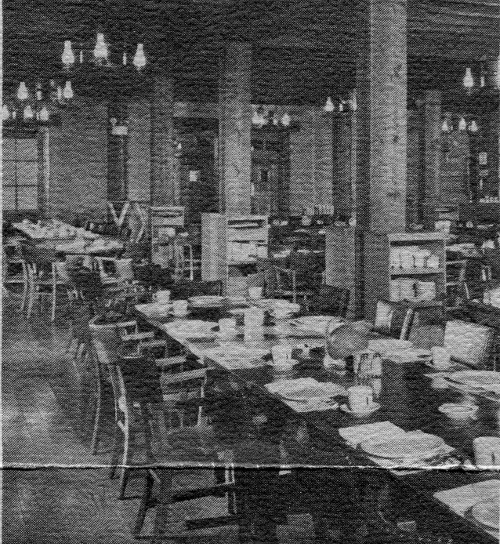
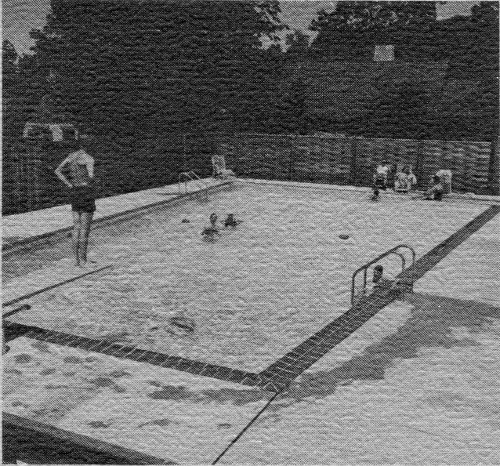
EUROPEAN PLAN—WITHOUT MEALS
| RATE PER DAY EFFECTIVE NOV. 1, 1969 European Plan—(Without Meals) Lodge or Guest Houses | ||||
|---|---|---|---|---|
| One Person | Two Persons | |||
| FULL SIZED BED | $10.50 | $13.50 | ||
| TWIN BEDS, 2 PERSONS | 15.00 | and | $16.00 | |
| ALL COTTAGE ROOMS | $15.00 | and | $15.50 | |
| ADDITIONAL PERSON IN SAME ROOM | $4.50 | |||
| NO CHARGE FOR CHILDREN UNDER 10 IF OCCUPYING SAME ROOM WITH PARENTS. | ||||
| Adult Rate Charged If Occupying Separate Rooms | ||||
| EXTRA CHARGE ON CRIBS AND ROLL AWAY BEDS IF USED | $1.00 | |||
| CHECKING OUT TIME IS 2:00 P.M. | ||||
| CHECKING IN TIME IS 3.00 P.M.—but we will assign you sooner if room is prepared. | ||||
Just above the Lodge—nestling in their woodland setting are the Guest Cottages—each containing 4 large rooms—modern in every respect—which are rented as separate rooms or en suite of 2 rooms. All are bedrooms, however, with either twin beds or double bed. Rooms are air conditioned.
| DINING ROOM HOURS | |
|---|---|
| WEEK DAYS: | |
| 8 to 9:30 A.M., 12 to 2; 6 to 7:30 P.M. | |
| SUNDAYS | April 1 to November 1: |
| 8 to 9:30 A.M.; 12 to 7:30 P.M. | |
| SUNDAYS | November 1 to April 1: |
| 8 to 9:30 A.M.; 12 to 2; 6 to 7:30 P.M. | |
All meals are served in our lovely air conditioned dining room located in the main Lodge building. The transient public is invited. Meals are reasonably priced. See prices listed below.
| TRANSIENT MEAL PRICES | |||||
|---|---|---|---|---|---|
| Breakfast | $1.50 | Luncheon | $2.60 | Dinner | $4.20 |
| Sunday and evening dinner | $4.20 | ||||
| Principal Holidays | $4.20 | ||||
| Children under 10— | |||||
| Breakfast | $1.00 | Lunch | $1.95 | Dinner | $3.20 |
| A la carte service available. | Special Child’s Menu | ||||
We cater to Dinner Parties—Weddings—Receptions
CONVENTIONS—Private Room available.
Cocktails available with lunch and dinner meals.
We have provided various games in the lobby and out of doors for your pleasure. Checkers, Chess, Indoor Shuffleboard (21 ft. long), Ping Pong, Television, World’s Largest Chess games (12 ft. square), and several other games.
Visit our curio and gift shop. Many interesting items are offered for your approval.
Pop corn is provided at the great fireplace during winter months. Out of door games—Shuffle boards, Horse Shoe courts. Two large and well equipped playgrounds for children. Five hole, par 3, GOLF COURSE. Ice Skating and Tobogganing in Winter.
Trail hikes with naturalist in charge daily at 10:00 and 2:00 except Tuesday, in season only.
Boating available at a small fee. Fishing boats available at dock. Riding horses for rent at stables. The trails are of unsurpassed beauty, winding thru the hills, giving you hours of delightful pleasure.
LARGE 50′ × 30′ HEATED SWIMMING POOL FOR OUR HOUSE GUESTS.
ALL DINING ROOMS AIR CONDITIONED
ALL BED ROOMS AIR CONDITIONED
TV IN ALL BED ROOMS
OPEN YEAR ’ROUND
Reservations should be made in advance. State number in party, children, if any, and their ages; day and time of arrival, as well as day of departure. Type of accommodations desired, also alternate type in case what you wish is not available. It is also desirable to select an alternate date. This will save time and unnecessary correspondence. All reservations should have enclosed a deposit of $5.00 for each and every room. In the event it is necessary to cancel, your deposit will be returned provided we are notified of such cancellation one week prior to day you are scheduled to arrive. Reservations held until 6 P.M., unless advised of later arrival. A reservation constitutes a contract for full payment of the room that is held for you.
No pets or dogs permitted in Lodge or Guest Houses.
FROM ST. LOUIS: North on Route 67 to Alton, turn left off the Bridge and continue (thru Alton) and on to the beautiful, scenic, new 4 lane highway (River Road) thru Grafton, direct to lodge.
FROM ALTON: New River Road as above or Route 100.
FROM JERSEYVILLE: Routes 109 and 100.
Address all written requests to: JERRY C. SMITH, Manager.
PERE MARQUETTE LODGE, Grafton, Illinois. Phone Grafton, Illinois - Area Code 618 786-3351. Ask for Reservation Clerk.
Rates are authorized by the Dept. of Conservation, Division of Parks, State of Illinois.

PERE MARQUETTE LODGE SEAL OF CUSTOMER SERVICE JERRY C. SMITH MGR
End of the Project Gutenberg EBook of Pere Marquette State Park, by Anonymous
*** END OF THIS PROJECT GUTENBERG EBOOK PERE MARQUETTE STATE PARK ***
***** This file should be named 59482-h.htm or 59482-h.zip *****
This and all associated files of various formats will be found in:
http://www.gutenberg.org/5/9/4/8/59482/
Produced by Stephen Hutcheson, Lisa Corcoran and the Online
Distributed Proofreading Team at http://www.pgdp.net
Updated editions will replace the previous one--the old editions will
be renamed.
Creating the works from print editions not protected by U.S. copyright
law means that no one owns a United States copyright in these works,
so the Foundation (and you!) can copy and distribute it in the United
States without permission and without paying copyright
royalties. Special rules, set forth in the General Terms of Use part
of this license, apply to copying and distributing Project
Gutenberg-tm electronic works to protect the PROJECT GUTENBERG-tm
concept and trademark. Project Gutenberg is a registered trademark,
and may not be used if you charge for the eBooks, unless you receive
specific permission. If you do not charge anything for copies of this
eBook, complying with the rules is very easy. You may use this eBook
for nearly any purpose such as creation of derivative works, reports,
performances and research. They may be modified and printed and given
away--you may do practically ANYTHING in the United States with eBooks
not protected by U.S. copyright law. Redistribution is subject to the
trademark license, especially commercial redistribution.
START: FULL LICENSE
THE FULL PROJECT GUTENBERG LICENSE
PLEASE READ THIS BEFORE YOU DISTRIBUTE OR USE THIS WORK
To protect the Project Gutenberg-tm mission of promoting the free
distribution of electronic works, by using or distributing this work
(or any other work associated in any way with the phrase "Project
Gutenberg"), you agree to comply with all the terms of the Full
Project Gutenberg-tm License available with this file or online at
www.gutenberg.org/license.
Section 1. General Terms of Use and Redistributing Project
Gutenberg-tm electronic works
1.A. By reading or using any part of this Project Gutenberg-tm
electronic work, you indicate that you have read, understand, agree to
and accept all the terms of this license and intellectual property
(trademark/copyright) agreement. If you do not agree to abide by all
the terms of this agreement, you must cease using and return or
destroy all copies of Project Gutenberg-tm electronic works in your
possession. If you paid a fee for obtaining a copy of or access to a
Project Gutenberg-tm electronic work and you do not agree to be bound
by the terms of this agreement, you may obtain a refund from the
person or entity to whom you paid the fee as set forth in paragraph
1.E.8.
1.B. "Project Gutenberg" is a registered trademark. It may only be
used on or associated in any way with an electronic work by people who
agree to be bound by the terms of this agreement. There are a few
things that you can do with most Project Gutenberg-tm electronic works
even without complying with the full terms of this agreement. See
paragraph 1.C below. There are a lot of things you can do with Project
Gutenberg-tm electronic works if you follow the terms of this
agreement and help preserve free future access to Project Gutenberg-tm
electronic works. See paragraph 1.E below.
1.C. The Project Gutenberg Literary Archive Foundation ("the
Foundation" or PGLAF), owns a compilation copyright in the collection
of Project Gutenberg-tm electronic works. Nearly all the individual
works in the collection are in the public domain in the United
States. If an individual work is unprotected by copyright law in the
United States and you are located in the United States, we do not
claim a right to prevent you from copying, distributing, performing,
displaying or creating derivative works based on the work as long as
all references to Project Gutenberg are removed. Of course, we hope
that you will support the Project Gutenberg-tm mission of promoting
free access to electronic works by freely sharing Project Gutenberg-tm
works in compliance with the terms of this agreement for keeping the
Project Gutenberg-tm name associated with the work. You can easily
comply with the terms of this agreement by keeping this work in the
same format with its attached full Project Gutenberg-tm License when
you share it without charge with others.
1.D. The copyright laws of the place where you are located also govern
what you can do with this work. Copyright laws in most countries are
in a constant state of change. If you are outside the United States,
check the laws of your country in addition to the terms of this
agreement before downloading, copying, displaying, performing,
distributing or creating derivative works based on this work or any
other Project Gutenberg-tm work. The Foundation makes no
representations concerning the copyright status of any work in any
country outside the United States.
1.E. Unless you have removed all references to Project Gutenberg:
1.E.1. The following sentence, with active links to, or other
immediate access to, the full Project Gutenberg-tm License must appear
prominently whenever any copy of a Project Gutenberg-tm work (any work
on which the phrase "Project Gutenberg" appears, or with which the
phrase "Project Gutenberg" is associated) is accessed, displayed,
performed, viewed, copied or distributed:
This eBook is for the use of anyone anywhere in the United States and
most other parts of the world at no cost and with almost no
restrictions whatsoever. You may copy it, give it away or re-use it
under the terms of the Project Gutenberg License included with this
eBook or online at www.gutenberg.org. If you are not located in the
United States, you'll have to check the laws of the country where you
are located before using this ebook.
1.E.2. If an individual Project Gutenberg-tm electronic work is
derived from texts not protected by U.S. copyright law (does not
contain a notice indicating that it is posted with permission of the
copyright holder), the work can be copied and distributed to anyone in
the United States without paying any fees or charges. If you are
redistributing or providing access to a work with the phrase "Project
Gutenberg" associated with or appearing on the work, you must comply
either with the requirements of paragraphs 1.E.1 through 1.E.7 or
obtain permission for the use of the work and the Project Gutenberg-tm
trademark as set forth in paragraphs 1.E.8 or 1.E.9.
1.E.3. If an individual Project Gutenberg-tm electronic work is posted
with the permission of the copyright holder, your use and distribution
must comply with both paragraphs 1.E.1 through 1.E.7 and any
additional terms imposed by the copyright holder. Additional terms
will be linked to the Project Gutenberg-tm License for all works
posted with the permission of the copyright holder found at the
beginning of this work.
1.E.4. Do not unlink or detach or remove the full Project Gutenberg-tm
License terms from this work, or any files containing a part of this
work or any other work associated with Project Gutenberg-tm.
1.E.5. Do not copy, display, perform, distribute or redistribute this
electronic work, or any part of this electronic work, without
prominently displaying the sentence set forth in paragraph 1.E.1 with
active links or immediate access to the full terms of the Project
Gutenberg-tm License.
1.E.6. You may convert to and distribute this work in any binary,
compressed, marked up, nonproprietary or proprietary form, including
any word processing or hypertext form. However, if you provide access
to or distribute copies of a Project Gutenberg-tm work in a format
other than "Plain Vanilla ASCII" or other format used in the official
version posted on the official Project Gutenberg-tm web site
(www.gutenberg.org), you must, at no additional cost, fee or expense
to the user, provide a copy, a means of exporting a copy, or a means
of obtaining a copy upon request, of the work in its original "Plain
Vanilla ASCII" or other form. Any alternate format must include the
full Project Gutenberg-tm License as specified in paragraph 1.E.1.
1.E.7. Do not charge a fee for access to, viewing, displaying,
performing, copying or distributing any Project Gutenberg-tm works
unless you comply with paragraph 1.E.8 or 1.E.9.
1.E.8. You may charge a reasonable fee for copies of or providing
access to or distributing Project Gutenberg-tm electronic works
provided that
* You pay a royalty fee of 20% of the gross profits you derive from
the use of Project Gutenberg-tm works calculated using the method
you already use to calculate your applicable taxes. The fee is owed
to the owner of the Project Gutenberg-tm trademark, but he has
agreed to donate royalties under this paragraph to the Project
Gutenberg Literary Archive Foundation. Royalty payments must be paid
within 60 days following each date on which you prepare (or are
legally required to prepare) your periodic tax returns. Royalty
payments should be clearly marked as such and sent to the Project
Gutenberg Literary Archive Foundation at the address specified in
Section 4, "Information about donations to the Project Gutenberg
Literary Archive Foundation."
* You provide a full refund of any money paid by a user who notifies
you in writing (or by e-mail) within 30 days of receipt that s/he
does not agree to the terms of the full Project Gutenberg-tm
License. You must require such a user to return or destroy all
copies of the works possessed in a physical medium and discontinue
all use of and all access to other copies of Project Gutenberg-tm
works.
* You provide, in accordance with paragraph 1.F.3, a full refund of
any money paid for a work or a replacement copy, if a defect in the
electronic work is discovered and reported to you within 90 days of
receipt of the work.
* You comply with all other terms of this agreement for free
distribution of Project Gutenberg-tm works.
1.E.9. If you wish to charge a fee or distribute a Project
Gutenberg-tm electronic work or group of works on different terms than
are set forth in this agreement, you must obtain permission in writing
from both the Project Gutenberg Literary Archive Foundation and The
Project Gutenberg Trademark LLC, the owner of the Project Gutenberg-tm
trademark. Contact the Foundation as set forth in Section 3 below.
1.F.
1.F.1. Project Gutenberg volunteers and employees expend considerable
effort to identify, do copyright research on, transcribe and proofread
works not protected by U.S. copyright law in creating the Project
Gutenberg-tm collection. Despite these efforts, Project Gutenberg-tm
electronic works, and the medium on which they may be stored, may
contain "Defects," such as, but not limited to, incomplete, inaccurate
or corrupt data, transcription errors, a copyright or other
intellectual property infringement, a defective or damaged disk or
other medium, a computer virus, or computer codes that damage or
cannot be read by your equipment.
1.F.2. LIMITED WARRANTY, DISCLAIMER OF DAMAGES - Except for the "Right
of Replacement or Refund" described in paragraph 1.F.3, the Project
Gutenberg Literary Archive Foundation, the owner of the Project
Gutenberg-tm trademark, and any other party distributing a Project
Gutenberg-tm electronic work under this agreement, disclaim all
liability to you for damages, costs and expenses, including legal
fees. YOU AGREE THAT YOU HAVE NO REMEDIES FOR NEGLIGENCE, STRICT
LIABILITY, BREACH OF WARRANTY OR BREACH OF CONTRACT EXCEPT THOSE
PROVIDED IN PARAGRAPH 1.F.3. YOU AGREE THAT THE FOUNDATION, THE
TRADEMARK OWNER, AND ANY DISTRIBUTOR UNDER THIS AGREEMENT WILL NOT BE
LIABLE TO YOU FOR ACTUAL, DIRECT, INDIRECT, CONSEQUENTIAL, PUNITIVE OR
INCIDENTAL DAMAGES EVEN IF YOU GIVE NOTICE OF THE POSSIBILITY OF SUCH
DAMAGE.
1.F.3. LIMITED RIGHT OF REPLACEMENT OR REFUND - If you discover a
defect in this electronic work within 90 days of receiving it, you can
receive a refund of the money (if any) you paid for it by sending a
written explanation to the person you received the work from. If you
received the work on a physical medium, you must return the medium
with your written explanation. The person or entity that provided you
with the defective work may elect to provide a replacement copy in
lieu of a refund. If you received the work electronically, the person
or entity providing it to you may choose to give you a second
opportunity to receive the work electronically in lieu of a refund. If
the second copy is also defective, you may demand a refund in writing
without further opportunities to fix the problem.
1.F.4. Except for the limited right of replacement or refund set forth
in paragraph 1.F.3, this work is provided to you 'AS-IS', WITH NO
OTHER WARRANTIES OF ANY KIND, EXPRESS OR IMPLIED, INCLUDING BUT NOT
LIMITED TO WARRANTIES OF MERCHANTABILITY OR FITNESS FOR ANY PURPOSE.
1.F.5. Some states do not allow disclaimers of certain implied
warranties or the exclusion or limitation of certain types of
damages. If any disclaimer or limitation set forth in this agreement
violates the law of the state applicable to this agreement, the
agreement shall be interpreted to make the maximum disclaimer or
limitation permitted by the applicable state law. The invalidity or
unenforceability of any provision of this agreement shall not void the
remaining provisions.
1.F.6. INDEMNITY - You agree to indemnify and hold the Foundation, the
trademark owner, any agent or employee of the Foundation, anyone
providing copies of Project Gutenberg-tm electronic works in
accordance with this agreement, and any volunteers associated with the
production, promotion and distribution of Project Gutenberg-tm
electronic works, harmless from all liability, costs and expenses,
including legal fees, that arise directly or indirectly from any of
the following which you do or cause to occur: (a) distribution of this
or any Project Gutenberg-tm work, (b) alteration, modification, or
additions or deletions to any Project Gutenberg-tm work, and (c) any
Defect you cause.
Section 2. Information about the Mission of Project Gutenberg-tm
Project Gutenberg-tm is synonymous with the free distribution of
electronic works in formats readable by the widest variety of
computers including obsolete, old, middle-aged and new computers. It
exists because of the efforts of hundreds of volunteers and donations
from people in all walks of life.
Volunteers and financial support to provide volunteers with the
assistance they need are critical to reaching Project Gutenberg-tm's
goals and ensuring that the Project Gutenberg-tm collection will
remain freely available for generations to come. In 2001, the Project
Gutenberg Literary Archive Foundation was created to provide a secure
and permanent future for Project Gutenberg-tm and future
generations. To learn more about the Project Gutenberg Literary
Archive Foundation and how your efforts and donations can help, see
Sections 3 and 4 and the Foundation information page at
www.gutenberg.org Section 3. Information about the Project Gutenberg
Literary Archive Foundation
The Project Gutenberg Literary Archive Foundation is a non profit
501(c)(3) educational corporation organized under the laws of the
state of Mississippi and granted tax exempt status by the Internal
Revenue Service. The Foundation's EIN or federal tax identification
number is 64-6221541. Contributions to the Project Gutenberg Literary
Archive Foundation are tax deductible to the full extent permitted by
U.S. federal laws and your state's laws.
The Foundation's principal office is in Fairbanks, Alaska, with the
mailing address: PO Box 750175, Fairbanks, AK 99775, but its
volunteers and employees are scattered throughout numerous
locations. Its business office is located at 809 North 1500 West, Salt
Lake City, UT 84116, (801) 596-1887. Email contact links and up to
date contact information can be found at the Foundation's web site and
official page at www.gutenberg.org/contact
For additional contact information:
Dr. Gregory B. Newby
Chief Executive and Director
gbnewby@pglaf.org
Section 4. Information about Donations to the Project Gutenberg
Literary Archive Foundation
Project Gutenberg-tm depends upon and cannot survive without wide
spread public support and donations to carry out its mission of
increasing the number of public domain and licensed works that can be
freely distributed in machine readable form accessible by the widest
array of equipment including outdated equipment. Many small donations
($1 to $5,000) are particularly important to maintaining tax exempt
status with the IRS.
The Foundation is committed to complying with the laws regulating
charities and charitable donations in all 50 states of the United
States. Compliance requirements are not uniform and it takes a
considerable effort, much paperwork and many fees to meet and keep up
with these requirements. We do not solicit donations in locations
where we have not received written confirmation of compliance. To SEND
DONATIONS or determine the status of compliance for any particular
state visit www.gutenberg.org/donate
While we cannot and do not solicit contributions from states where we
have not met the solicitation requirements, we know of no prohibition
against accepting unsolicited donations from donors in such states who
approach us with offers to donate.
International donations are gratefully accepted, but we cannot make
any statements concerning tax treatment of donations received from
outside the United States. U.S. laws alone swamp our small staff.
Please check the Project Gutenberg Web pages for current donation
methods and addresses. Donations are accepted in a number of other
ways including checks, online payments and credit card donations. To
donate, please visit: www.gutenberg.org/donate
Section 5. General Information About Project Gutenberg-tm electronic works.
Professor Michael S. Hart was the originator of the Project
Gutenberg-tm concept of a library of electronic works that could be
freely shared with anyone. For forty years, he produced and
distributed Project Gutenberg-tm eBooks with only a loose network of
volunteer support.
Project Gutenberg-tm eBooks are often created from several printed
editions, all of which are confirmed as not protected by copyright in
the U.S. unless a copyright notice is included. Thus, we do not
necessarily keep eBooks in compliance with any particular paper
edition.
Most people start at our Web site which has the main PG search
facility: www.gutenberg.org
This Web site includes information about Project Gutenberg-tm,
including how to make donations to the Project Gutenberg Literary
Archive Foundation, how to help produce our new eBooks, and how to
subscribe to our email newsletter to hear about new eBooks.